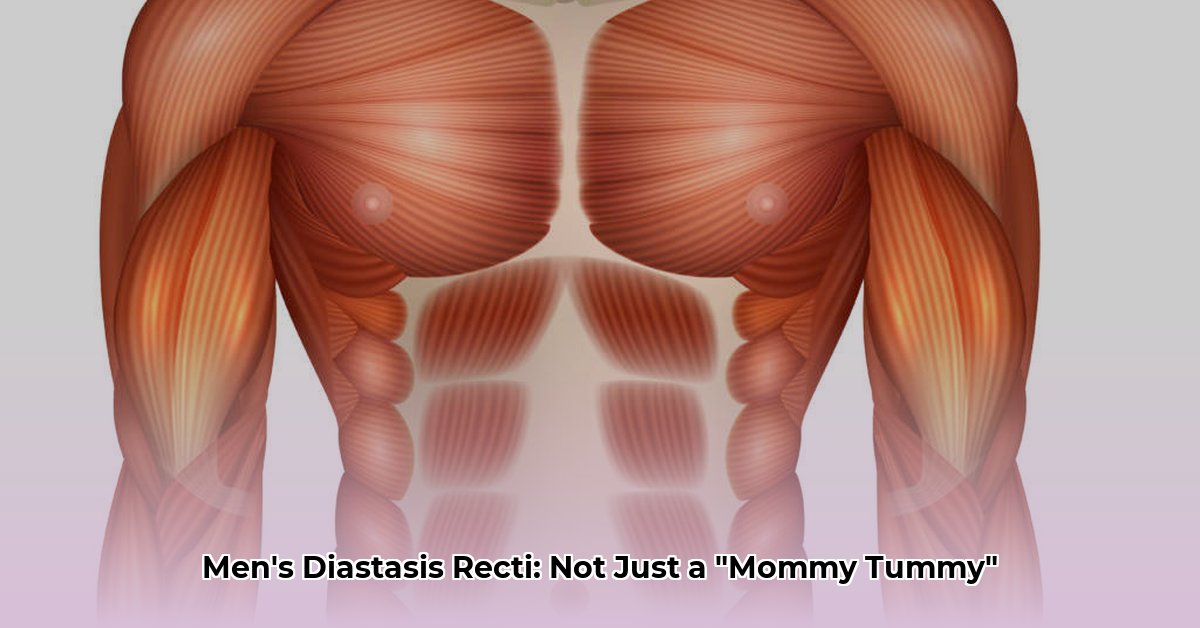Understanding Abdominal Separation
Diastasis recti, often referred to as abdominal separation, isn’t exclusive to women. It occurs in men too, affecting the rectus abdominis muscles – the prominent “six-pack” muscles. These muscles are connected by a band of tissue called the linea alba. Diastasis recti happens when this tissue stretches and thins, widening the gap between the muscles.
What Causes It?
Unlike women, where pregnancy is the primary cause, diastasis recti in men is often linked to other factors:
- Incorrect Weightlifting: Lifting heavy weights improperly, especially during exercises like crunches or sit-ups, strains the linea alba, potentially leading to separation. Maintaining proper form and engaging your core correctly is crucial.
- Weight Fluctuations: Rapid weight gain or loss can stress the linea alba, increasing the risk of diastasis recti.
- Medical Conditions: Certain conditions, such as cirrhosis of the liver or abdominal tumors, can increase abdominal pressure or weaken connective tissue, potentially contributing to diastasis recti.
- Aging: As we age, the linea alba may lose elasticity, making it more susceptible to stretching.
- Genetics: A predisposition to weaker connective tissue can increase the likelihood of developing diastasis recti.
Recognizing the Symptoms
Diastasis recti can manifest in various ways:
- Abdominal Bulge: A noticeable protrusion along the midline of the abdomen, especially when straining, is a key sign.
- Lower Back Pain: Weakened core muscles can lead to back pain.
- Digestive Problems: Issues like constipation or bloating can occur.
- Pelvic Floor Dysfunction: Problems with bladder control may arise.
- Postural Changes: Weakened core muscles can affect posture.
Getting a Diagnosis
If you suspect diastasis recti, consult a doctor or physical therapist. They’ll perform a physical exam, checking for the separation and assessing its width. Imaging tests, like ultrasound, may be recommended for a more detailed evaluation.
Treatment Options: A Step-by-Step Approach
Treatment aims to strengthen core muscles and reduce the separation.
1. Expert Guidance: Consulting a physical therapist is crucial for personalized guidance.
2. Targeted Exercises: Specific exercises are essential, and a physical therapist can recommend the most effective ones for your case. Examples (always consult your therapist first):
- Belly Breathing with Abdominal Contraction: Inhale deeply, expanding your belly. Exhale, drawing your belly button toward your spine.
- Pelvic Tilts: Lie on your back with knees bent, gently rocking your pelvis back and forth.
- Heel Slides: Lie on your back with knees bent, sliding one heel out and back while keeping your core engaged.
- Toe Taps: Lie on your back with knees bent and feet flat on the floor. Gently tap your toes on the floor, one at a time, keeping your core muscles engaged.
- Bird Dog: Start on your hands and knees. Extend one arm forward and the opposite leg back, maintaining a straight line from hand to heel. Hold briefly, then switch sides.
3. Avoid Harmful Exercises: Crunches, sit-ups, heavy lifting without proper form, and twisting exercises can worsen the separation.
4. Bracing: Support belts can provide temporary relief but aren’t a long-term solution. A physical therapist can recommend appropriate bracing if needed.
5. Surgery (Last Resort): Surgery is typically reserved for severe cases or when other treatments fail. It may involve stitching the muscles or using mesh to reinforce the abdominal wall.
Preventing Diastasis Recti
Taking proactive steps can significantly reduce your risk.
- Maintain a Healthy Weight: Excess weight strains the abdominal wall.
- Lift Properly: Use correct form when lifting weights.
- Core Strengthening: Regularly engage in core-strengthening exercises.
- Good Posture: Maintaining good posture supports the abdominal muscles.
- Controlled Movements: Avoid jerky or sudden abdominal movements, especially during exercise.
- Gradual Exercise Progression: Increase exercise intensity gradually, allowing your abdominal muscles to adapt.
Long-Term Impact of Untreated Diastasis Recti
Ignoring diastasis recti can potentially lead to:
- Hernias: Weakened abdominal muscles can increase the risk of hernias.
- Chronic Back Pain: Weakened core muscles can’t adequately support the spine.
- Functional Limitations: Diastasis recti can impair everyday activities.
- Pelvic Floor Issues: Untreated diastasis recti might contribute to ongoing pelvic floor problems.
- Decreased Athletic Performance: Core weakness can limit performance in various sports and physical activities.
Living with Diastasis Recti
Dealing with diastasis recti can be challenging, but support is available. Connect with online or in-person support groups to share experiences and gain encouragement.
Finding a Specialist
Consult a physical therapist specializing in pelvic floor and abdominal rehabilitation. Your primary care physician can provide referrals.
Frequently Asked Questions (FAQs)
Q: Can diastasis recti heal on its own?
A: It’s unlikely. Targeted exercises and professional guidance are usually necessary.
Q: Is surgery always required?
A: No. Surgery is typically a last resort.
Q: How long does recovery take?
A: Recovery varies based on the severity and individual factors. Consistency with exercises is essential. It often takes several months of dedicated effort.
Q: Can I exercise if I have diastasis recti?
A: Yes, but certain exercises should be avoided. A physical therapist can guide you on safe and effective exercises.
Q: What kind of doctor should I see for diastasis recti?
A: Start with your primary care physician, who can refer you to a specialist like a physical therapist specializing in pelvic floor health or a general surgeon if needed.
Important Note: This information is for educational purposes and does not substitute professional medical advice. Consult a healthcare professional for diagnosis and treatment.
- Bento Box Shopping Tips for Smart and Stylish Lunch Prep - December 14, 2025
- Bento Box Trays Streamline Restaurant Meal Presentation and Transport - December 13, 2025
- Plastic Bento Boxes Face Scrutiny Over Sustainability Impacts - December 11, 2025










